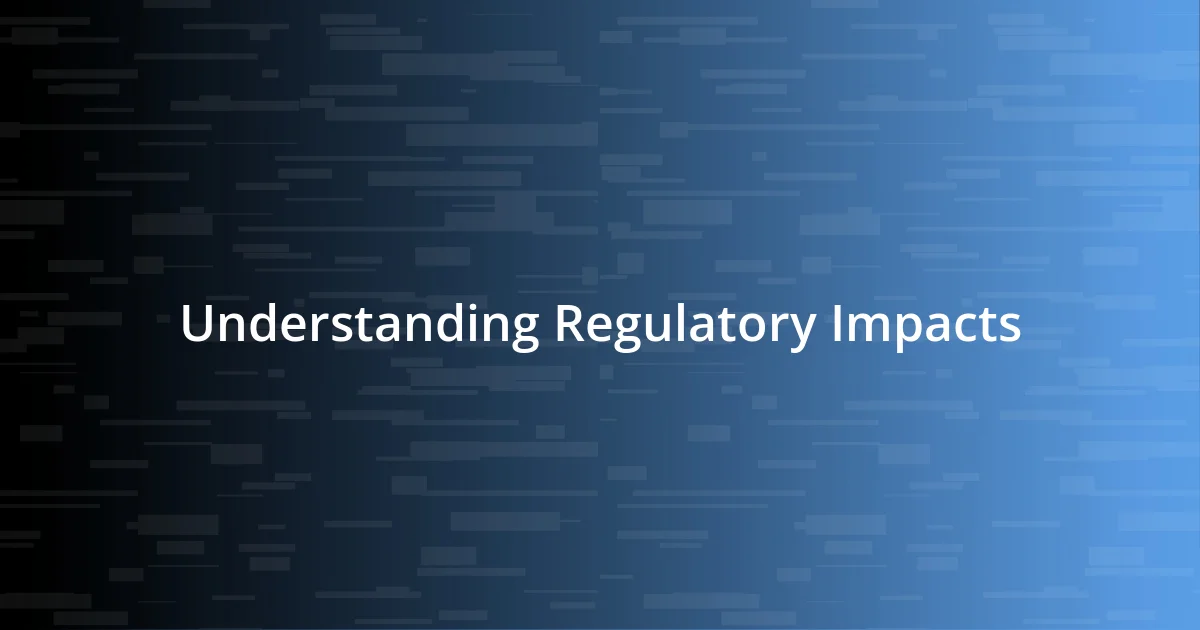Key takeaways:
- Regulatory changes, driven by technology, public pressure, and economic conditions, significantly impact businesses, often creating a tension between safety and innovation.
- Compliance practices should focus on fostering a culture of awareness and open communication, utilizing technology to streamline compliance processes effectively.
- Future regulatory trends emphasize sustainability and international cooperation, raising questions about the preparedness of businesses to adapt and the trustworthiness of technology in ethical decision-making.

Understanding Regulatory Impacts
Regulatory impacts can feel abstract at times, but I’ve seen firsthand how they shape industries. For example, when new safety regulations were introduced in my previous workplace, it transformed our safety protocols overnight. I remember feeling a mix of anxiety and curiosity—how would these changes affect our daily operations?
It’s fascinating how regulations aim to create a fair playing field, but they can sometimes leave smaller players struggling to keep up. I’ve worked with startups that genuinely felt overwhelmed by compliance costs, prompting me to wonder, how can we balance safety and innovation? This tension is a vital part of understanding regulatory impacts; it’s not just about rules but about the realities they impose on businesses and their growth.
Regulatory changes can also spark significant emotional responses within teams and organizations. I once witnessed a colleague’s relief when our compliance upgrades ultimately led to a safer work environment. It’s these personal stories that illuminate the deeper implications of regulatory impacts—beyond the statistics, they affect real lives and motivate change at every level.

Key Drivers of Regulatory Changes
Regulatory changes are often driven by emerging technologies and societal shifts, which reshape the landscape in ways we can’t ignore. I recall when digital privacy laws began to emerge; it sparked conversations in my circle about how technology companies needed to adapt. This change felt particularly urgent as we all recognized how our data was becoming a hot commodity.
Public pressure also plays a tremendous role. I remember someone giving a passionate speech about environmental regulations at a community meeting. The collective determination to hold corporations accountable was palpable. It made me realize that when people unite for a cause, regulators often have no choice but to listen, responding to the voices of concerned citizens.
Economic conditions, such as a recession or market boom, can catalyze regulatory changes as well. In a past role, I noticed that during an economic downturn, there was a push for stricter consumer protection laws to safeguard the vulnerable. This connection between financial stability and regulatory adjustments highlights that the economic climate is not just a backdrop; it actively shapes the regulatory framework.
| Key Driver | Description |
|---|---|
| Technological Advancements | Emerging technologies often necessitate new regulations to ensure public safety and privacy. |
| Public Pressure | Grassroots movements and advocacy can drive legislative changes as regulators respond to societal demands. |
| Economic Conditions | The financial climate influences regulatory priorities, leading to adjustments aimed at stabilizing or protecting sectors. |

Economic Effects of Regulation
The economic effects of regulation are often multifaceted and can lead to dramatic shifts in how businesses operate. I’ve personally watched as new labor laws changed how our team managed resources—tightening up budgets and requiring us to rethink our staffing strategies. While it pushed us towards more efficient practices, I remember the anxiety that came with worrying about potential layoffs and the impact on team morale. The ripple effects of regulations can sometimes feel overwhelming.
Here’s a brief overview of the specific economic effects I’m referring to:
- Increased Compliance Costs: Businesses may face heavy financial burdens as they adapt to new regulations, often leading to reallocating resources.
- Market Entry Barriers: Stricter regulations can prevent smaller companies or startups from entering the market due to costs and complexity.
- Innovation Stimulation: While regulations can stifle some advancements, they can also inspire innovation, as companies seek creative solutions to meet new standards.
Ultimately, the balance of these effects influences not just company outcomes, but community well-being and employee security. It’s a dynamic that warrants careful consideration and discussion.

Case Studies on Regulatory Impacts
One notable case study is the impact of the General Data Protection Regulation (GDPR) in the European Union. I vividly remember the intense discussions my colleagues and I had when it was implemented. It was remarkable to see how companies transformed their data management processes overnight, pouring resources into compliance. The emotional weight of the changes was palpable, as many feared data breaches and fines could cripple smaller entities.
Another example involves the Clean Air Act in the United States. When I attended a local workshop on environmental policies, I was struck by the testimonies of small businesses adapting to stricter emissions standards. It was inspiring to hear how some were not only compliant but had also innovated by using cleaner technologies. But I couldn’t help but ask: at what cost? The struggle to balance profitability and sustainability is ongoing, and I deeply empathize with those trying to navigate this landscape.
Lastly, consider how recent regulations in the gig economy have affected workers’ rights. I recall a friend of mine who worked as a rideshare driver, passionately sharing how new labor laws provided important protections, yet also led to reduced hours and earnings for many drivers. This dual impact raises essential questions about whether policy changes truly benefit the workers they aim to protect, as the emotional stakes are incredibly high for those reliant on such jobs.

Best Practices for Compliance
To ensure compliance effectively, it’s crucial to foster a culture of awareness within your organization. In my experience, regular training sessions on compliance issues can transform how employees perceive regulations. I recall a workshop I attended where the speaker emphasized the importance of understanding the ‘why’ behind regulations. The excitement among staff was palpable as they realized their role in upholding company ethics and legality.
Another best practice I’ve found invaluable is the establishment of clear communication channels for reporting compliance concerns. There was a time when I worked at a firm where employees hesitated to voice their worries about potential violations. By implementing an anonymous reporting system, we noticed a significant uptick in compliance-related discussions. It’s amazing how this empowered voice can mitigate risks before they escalate, don’t you think? Encouraging open dialogue not only improves oversight but also builds trust within the team.
Ultimately, leveraging technology is a game-changer in maintaining compliance. I often reflect on when our company adopted compliance software to streamline tracking and documentation. The relief was immediate; it reduced the manual oversight burden and made audits far less daunting. Have you considered how tech could simplify your compliance processes? Embracing these tools can transform compliance from a burden into a seamless part of your operational strategy.

Future Trends in Regulation
As I look ahead, I can’t help but notice the growing trend of regulations emphasizing sustainability and environmental impact. During a recent conference on corporate responsibility, I was struck by a speaker’s assertion that businesses will soon be evaluated not just on profits but also on their ecological footprints. This shift has me wondering: how prepared are companies to adapt to this new scrutiny? It’s hard to ignore the emotional tug of wanting to contribute positively to our planet while navigating the challenges of compliance.
Another emerging trend is the increased use of technology in monitoring compliance. I remember when our team first employed AI tools to analyze regulatory changes; the excitement was tangible. It felt revolutionary to have complex regulations distilled into actionable insights almost instantly. But with this technology comes a daunting question: can we trust algorithms to handle the nuances of human ethics and integrity? I sometimes catch myself pondering if reliance on technology could inadvertently overlook the very essence of what regulations aim to accomplish.
Finally, I foresee a stronger focus on international cooperation in regulatory frameworks. After attending a global summit a while back, I was inspired by the collaborations forming across borders to tackle issues like tax evasion and corporate governance. It was refreshing to witness different nations unite under shared goals. However, I can’t shake the feeling that aligning diverse legal systems will be no small feat. How do we harmonize regulations that respect cultural nuances while striving for universal standards? The path forward is bound to be complex, but the urgency for collective solutions has never been clearer.

Evaluating Regulatory Impact Effectiveness
Evaluating the effectiveness of regulatory impacts often requires looking beyond just compliance metrics. I remember sitting in a review meeting where we analyzed whether a new regulation actually changed behaviors, not just if it was followed. It was eye-opening to realize that success isn’t just about ticking boxes; it’s about fostering a genuine shift in mindset.
One particular instance stands out to me: a new safety regulation was implemented in my previous workplace, and we took the time to gather employee feedback afterward. The insights revealed a mix of compliance and a deeper understanding of why those regulations mattered—ultimately leading to safer practices driven by personal investment. I often wonder, what more could we achieve if we routinely engaged employees in these discussions? It’s fascinating how such conversations can uncover nuances that raw data can miss.
On a broader scale, metrics such as error rates before and after a regulation are essential, but I believe there’s a personal dimension that’s just as crucial. I’ve seen teams thrive when they actively engage with the guidelines rather than just adhering to them. Isn’t it worth questioning if our regulatory frameworks encourage this kind of engagement? Effective evaluation surely means creating systems that resonate with people’s lives and experiences.














